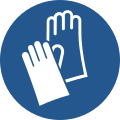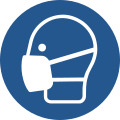Basic hygiene
Basic hygiene measures (including standard hygiene ) prevent the transmission of pathogens and thus nosocomial infections in general patient care . They apply to medical and caregiver staff in hospitals and other health care facilities where people are examined, treated and cared for.
indication
Since people without recognizable symptoms of the disease can be colonized or infected with infectious agents that can be transmitted from person to person, certain standard preventive measures are generally applied to every patient. The basic hygiene measures that must always be observed serve to protect other patients as well as the protection of staff. The implementation is defined in the facility's internal hygiene plan, which in Germany is generally based on the recommendations of the Commission for Hospital Hygiene and Infection Prevention (KRINKO).
Components of basic hygiene according to KRINKO
According to the KRINKO recommendations, basic hygiene includes hand hygiene, the cleaning and disinfection of surfaces, advanced protective measures (barrier measures) to prevent infection in the case of communicable diseases, the preparation of medical products and laundry, handling of dishes, hygiene for individual medical measures, patient education and training and their visitors, the type of accommodation, waste disposal, the structural and functional design and equipment of functional units (e.g. endoscopy) and the requirements for decentralized disinfectant dosing devices.
Hand hygiene
Hand hygiene is the most important basic hygiene measure. Hand hygiene includes washing and disinfecting hands. The fingernails must be short and unpainted; no jewelry or wristwatches may be worn on the hands or forearms.
Hand-washing stations must meet the structural requirements of the Technical Rules for Biological Agents (TRBA 250): Easily accessible, with running warm and cold water, as well as fittings that can be operated without hand contact (e.g. single-lever mixer taps with an extended lever that can be operated with the elbow are). In addition, hand-operated dispensers must be attached, one each for skin cleansing agents and one for hand disinfectants . Bar soaps are not recommended because of possible contamination . In addition, a disposable towel dispenser as well as a skin protection and skin care product must be available.
Behavior when coughing, sneezing and blowing your nose
The so-called cough etiquette - which also applies to sneezing - is an integral part of standard hygiene based on experience with the SARS pathogen. When coughing or sneezing, avoid spraying saliva or nasal secretions into the area. If the hand is held in front of the mouth when coughing or sneezing, pathogens get to the hands and can then be passed on via shared objects or when shaking hands. Therefore, certain rules should be observed: when coughing or sneezing, turn away as possible and keep your distance from other people, use paper tissues only once and dispose of them directly in a waste bin with a lid. If there is no handkerchief, the crook of your arm should be held in front of your mouth and nose. Then the hands must be washed and disinfected thoroughly.
Workwear
Work, occupational or department clothing is worn instead of or in addition to private clothing at work. The study situation is not yet sufficient to clearly determine the role of clothing in the transmission of infectious agents. Since some microorganisms can survive in the inanimate environment - including on textiles - tests showed that it was mainly hand contact points on clothing (e.g. smock pockets) that were contaminated. According to KRINKO, evidence of contamination of the work clothes of employees in patient care with pathogens does not prove the transmission of pathogenic germs to other patients. Therefore she does not give any recommendation for this. However, especially for care professions, there are labor law requirements from the TRBA 250 (Technical Rules for Biological Agents), the Biological Agents Ordinance (BioStoffV) § 8 and 9, the collective bargaining law and the KRINKO recommendation from 1985 according to the Federal Health Gazette 28.
In contrast, the National Institute for Health and Care Excellence (NICE) in Great Britain has been advocating the “bare below elbows” principle since 2012, according to which, among other things, short-sleeved work clothes are recommended.
Personal protective equipment
Wearing personal protective equipment (PPE) is a barrier measure. Depending on the area of application and activity, certain pieces of protective clothing are required alone or in combination. These include disposable gloves , apron or gown, full-face protection or a higher respiratory protection , a safety goggles or a face shield and hair protection and overshoes .
Non-sterile disposable gloves are also used for hand disinfection, if there is a potential for contact with blood, secretions, excreta or likely contaminated surfaces. Since the hands can be contaminated when removing disposable gloves or through leaks, hand disinfection is always required afterwards. An apron or a protective gown protects the work clothing from direct contact with blood, secretions, excreta or other potentially contaminated materials during examinations, interventions or care measures . Liquid-tight aprons can be worn alone or in addition to a protective gown during wet work. Mouth and nose protection is especially necessary for certain aseptic activities on the patient in order to protect him from microorganisms that, for. B. be given while speaking. Safety glasses or a face shield are recommended if blood or secretions could be splashed. In the area of reverse insulation , hair protection and overshoes are also required.
As a rule, all protective materials are only intended for single use, with the exception of fabric coats: These are reprocessed like infectious laundry after use.
Surface cleaning and disinfection
Areas at risk with frequent hand and skin contact are cleaned and disinfected at least daily; in the event of contamination, reprocessing must take place immediately.
Hygiene during aseptic activities
The basics of aseptic work must be observed when preparing and performing certain, sometimes invasive, measures . These include injections and punctures, mixing infusion solutions, placing a transurethral urinary catheter and treating wounds.
Processing of medical devices
Medical devices are processed in accordance with the recommendations of KRINKO and the Federal Institute for Drugs and Medical Devices (BfArM).
Laundry disposal, preparation and supply, bed hygiene
Used or contaminated laundry is collected and transported in appropriately safe containers so that it does not pose a risk of infection or contamination. Laundry from medical facilities is treated with disinfecting, regularly checked procedures with proven effectiveness. The laundry must then be stored in such a way that it remains clean, low in germs and free of residues until it is used.
Before being occupied again, beds must be disinfected and covered with disinfected inlays and clean linen. As an exception, after a corresponding risk assessment, a disinfectant preparation of the inlets between two patients can be dispensed with.
Handling dishes
Dishes should preferably be prepared by machine. The corresponding food hygiene requirements apply so that the patient always receives clean and disinfected dishes. The risk of contamination must be ruled out during transport to the patient or the dishes used.
literature
- Infection prevention as part of the care and treatment of patients with communicable diseases. Recommendation of the Commission for Hospital Hygiene and Infection Prevention (KRINKO) at the Robert Koch Institute. Federal Health Gazette 2015, 58: 1151–1170 Springer-Verlag Berlin, Heidelberg 2015, doi : 10.1007 / s00103-015-2234-2
Web links
- W. Popp, K.-D. Zastrow: Hygiene Tip, February 2016. German Society for Hospital Hygiene
Individual evidence
- ↑ a b M. Mielke; A. Nassauer (Robert Koch Institute): Derivation of risk-minimizing, here infection-preventive measures in practice. Importance of standard hygiene and, if necessary, additional measures to protect patients and staff from nosocomial infections. November 2009, p. 2; accessed on March 12, 2019.
- ↑ Basic hygiene , KRINKO recommendations; Status: January 28, 2019; accessed on March 12, 2019.
- ↑ Hand hygiene in health care facilities. Bundesgesundheitsblatt 2016, 59: 1189–1220 doi : 10.1007 / s00103-016-2416-6 , p. 1190.
- ↑ Recommendations of the Commission for Hospital Hygiene and Infection Prevention (KRINKO) at the Robert Koch Institute ; accessed on March 12, 2019.
- ↑ TRBA 250 Biological agents in health and welfare work. As of 2018, pp. 13–14 ; accessed on September 26, 2019
- ↑ Hand hygiene in health care facilities. Bundesgesundheitsblatt 2016, 59: 1189–1220 doi : 10.1007 / s00103-016-2416-6 , p. 1211. Accessed on September 26, 2019.
- ↑ Hygiene when coughing and sneezing. Cough and sneeze properly. In: infektionsschutz.de. Federal Center for Health Education, accessed on March 9, 2020 .
- ↑ Clothing and protective equipment for care professions from a hygienic point of view. Updated version July 2016. DGKH section “Hygiene in outpatient and inpatient nursing and geriatric care / rehabilitation” in consensus with the DGKH board; accessed on March 14, 2019.
- ↑ National Institute for Health and Care Excellence (2012): Infection: Prevention and control of health-related infections in primary and community care. NICE clinical guideline 139
- ↑ a b W. Popp, K.-D. Zastrow: Hygiene Tip, February 2016. German Society for Hospital Hygiene; accessed on March 17, 2019
- ↑ Hygiene requirements for the reprocessing of medical devices. Federal Health Gazette 2012; 55: 1244-1310 doi : 10.1007 / s00103-012-1548-6 .




